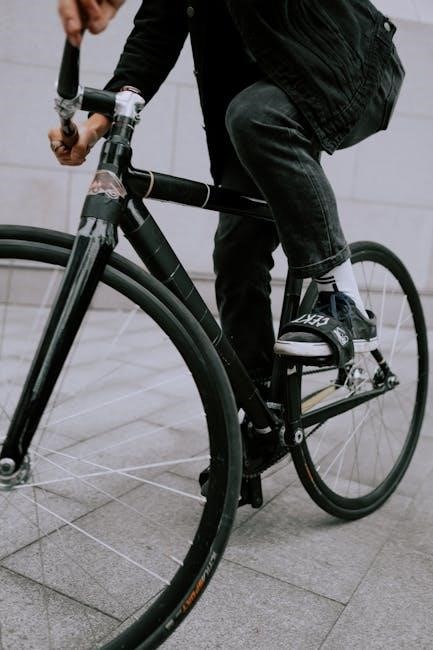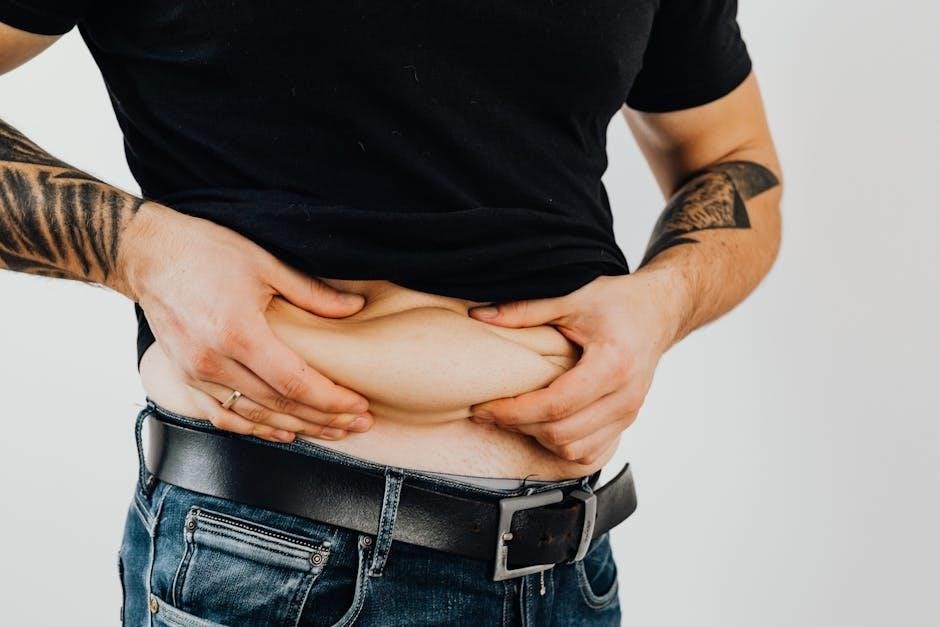
A well-fitting pair of jeans enhances style, comfort, and confidence. This guide helps men navigate measurements, body types, fabric choices, and styling tips to find their perfect fit effortlessly;

Why Proper Fit Matters
A proper fit in jeans is essential for both comfort and style. Ill-fitting jeans can lead to discomfort, restricted mobility, and an unflattering appearance. A well-fitting pair enhances confidence, allowing men to move freely while looking sharp. Whether for casual or formal occasions, the right fit ensures jeans complement the body shape without being too tight or too loose. Investing time in finding the perfect fit pays off in long-term satisfaction and versatility for any wardrobe.
Key Features of a Great Fit
A great fit in jeans involves several key elements. The waist should sit comfortably without needing a belt, while the thigh should offer a balance of comfort and structure. The inseam and outseam must align with body proportions, ensuring the correct length. Fabric quality and stretch also play a role, affecting both comfort and durability. A flattering fit enhances posture, movement, and overall appearance, making it essential to consider these factors when selecting the perfect pair of jeans.
Understanding Jeans Measurements
Jean measurements include waist size, inseam, and thigh circumference. Accurate measurements ensure a perfect fit, balancing comfort and style while catering to different body types and preferences.
Waist Size: How to Measure Correctly
Measuring your waist accurately is key to a perfect fit. Wrap a flexible tape measure around your natural waistline, typically just above the hipbone and below the ribcage. Ensure the tape is snug but not tight, keeping the measure level and parallel to the floor. This measurement determines your ideal jeans size, ensuring comfort and style without restriction or excess fabric.
Inseam and Outseam: Finding the Right Length
To ensure the perfect length, measure the inseam (inside of the leg from crotch to ankle) and outseam (outside from waist to hem). The inseam determines the pant length, while the outseam affects the overall look. Jeans with a longer inseam suit taller men, while shorter inseams are ideal for shorter builds. Outseam length can vary based on style, with options like cropped, regular, or extra-long hems to suit personal preference and body proportions for a polished appearance.
Thigh Measurement: Ensuring Comfort and Mobility
Thigh measurement is crucial for comfort and mobility. The jeans should neither be too tight, restricting movement, nor too loose, compromising style. For athletic builds, a slightly roomier thigh fit is recommended. Stretch denim offers added flexibility, while rigid fabrics provide structure. Ensure the thigh measurement aligns with your body type and lifestyle, whether for everyday wear or active use, to maintain both comfort and a polished look without sacrificing functionality or personal style preferences.
Body Types and Jeans Fit
Jeans fit varies by body type, ensuring comfort and style. Athletic builds suit slim fits, balanced types prefer straight legs, while relaxed fits cater to comfort-seekers.
Slim Fit for Athletic Builds
Slim-fit jeans are ideal for men with athletic builds, offering a tailored look that accentuates muscle definition. They provide a snug fit through the thigh and knee, creating a streamlined appearance. Designed for comfort and style, slim-fit jeans are perfect for those who want to showcase their physique without sacrificing mobility. Pair with stretch denim for enhanced flexibility, ensuring a comfortable fit even during active days. This style complements broad shoulders and toned legs, making it a versatile choice for both casual and semi-formal outings.
Straight Fit for Balanced Body Types
Straight-fit jeans are tailored for men with balanced body types, offering a classic style that sits comfortably on the waist and hips. This fit is neither too tight nor too loose, providing a clean, timeless look. The leg opening is moderate, creating a versatile silhouette that suits both casual and semi-formal settings. Straight-fit jeans complement a variety of body types without clinging excessively, ensuring all-day comfort while maintaining a polished appearance. They are ideal for those seeking a balanced blend of style and practicality in their denim.
Relaxed Fit for Comfort-Seekers
Relaxed-fit jeans are perfect for men prioritizing comfort without sacrificing style. These jeans offer a loose fit through the thigh and seat, creating a comfortable, laid-back silhouette. They are ideal for casual outings and everyday wear, providing ample room for movement. The relaxed fit suits larger or more muscular builds, ensuring a cozy feel while maintaining a stylish appearance. This versatile option is great for those who value ease and relaxation in their denim choice, making it a go-to for effortless, comfortable fashion.

Fabric and Wash: Impact on Fit
Fabric and wash significantly impact jeans’ fit. Cotton offers durability, while stretch denim provides flexibility. Light washes may soften over time, affecting fit, whereas dark washes retain shape better, balancing comfort and style.

Cotton vs. Stretch Denim
Cotton denim is durable and breathable, offering a classic fit that softens over time. Stretch denim blends, like elastane, provide flexibility and recovery, ideal for athletic builds or those seeking comfort. Cotton jeans maintain their shape well, while stretch denim offers ease of movement. Choosing between them depends on your priority: durability and structure with cotton, or comfort and flexibility with stretch denim. Both options ensure a great fit when paired with the right measurements and style.
Light Wash vs. Dark Wash
Light wash jeans create a relaxed, casual look and can make legs appear shorter, while dark wash offers a sleek, polished appearance and elongates the legs. Light washes are perfect for summer or casual outfits, pairing well with vibrant tops. Dark washes are versatile for both formal and informal settings, complementing button-down shirts or blazers. Each wash impacts styling versatility, so choose based on your desired aesthetic and the occasion to ensure a flattering and cohesive look.
Common Fit Styles Explained
Understanding common fit styles is key to finding the perfect pair of jeans. From slim to straight, relaxed, bootcut, and skinny, each offers a unique silhouette. These styles cater to various preferences and body types, ensuring a flattering fit for everyone.
Slim Fit vs. Skinny Jeans
Slim Fit and Skinny Jeans are often confused but differ in fit and style. Slim Fit jeans are snug through the thigh, tapering slightly from the knee down, offering a modern, streamlined look without being overly tight. Skinny Jeans, however, are tighter throughout, often stretchy, and cling closer to the leg, creating a bold, fashion-forward appearance. Both styles flatter athletic builds but cater to different preferences: Slim Fit for versatility and Skinny Jeans for a trendier, edgier vibe.

Bootcut vs. Straight Leg
Bootcut jeans are wider from the knee down, creating a balanced silhouette, while Straight Leg jeans maintain a consistent width. Bootcut suits athletic builds or those wanting to balance proportions, and they fit well with boots. Straight Leg offers a clean, classic look, versatile for most body types. Both styles provide comfort and timeless appeal, catering to different preferences and fashion goals.

Waist Types and Rise
Jeans come in low-rise, mid-rise, and high-rise options. Low-rise offers a trendy, modern look, while mid-rise provides comfort and support. High-rise styles are both fashionable and comfortable.

Low-Rise vs. Mid-Rise vs. High-Rise
Low-rise jeans sit below the natural waistline, offering a modern, trendy look and a relaxed fit. Mid-rise styles provide a balance of comfort and style, sitting just below the belly button. High-rise jeans, often seen as retro, offer maximum comfort and support, sitting above the natural waistline. Each rise caters to different body types and preferences, ensuring a flattering fit for every man.
Inseam and Hemming
Inseam refers to the inside leg measurement, determining pant length. Proper inseam ensures a flattering fit, while hemming allows for adjustments to achieve the perfect style without excess fabric.
How to Determine the Perfect Inseam
To find the ideal inseam, measure the inside of your leg from the crotch to the bottom of your ankle. For jeans, subtract 1-2 inches to ensure they break slightly above your shoes. Use a flexible tape measure and consider your shoe height. If you prefer a shorter or longer style, adjust accordingly. Proper inseam length ensures a balanced look, preventing excessive fabric pooling or a too-short hem. This step is crucial for a polished, tailored appearance.

Styling Tips for Different Fits
Mastering your denim style starts with pairing the right fit with complementary tops and shoes. Balance proportions and create a cohesive look that reflects your personal fashion.
Pairing Jeans with Tops and Shoes
Pairing your jeans with the right tops and shoes can elevate your style. Slim-fit jeans look sharp with tailored shirts, while straight-leg styles complement casual wear like graphic tees. For footwear, loafers or sneakers add a polished touch, while boots create a rugged vibe. Balance proportions by matching loose tops with slim jeans and vice versa. Experiment with layering, like adding a blazer for a refined look or a leather jacket for edge, to create versatile outfits that suit any occasion.

Care and Maintenance
Preserve your jeans by washing them inside out in cold water and avoiding harsh detergents. Air-dry to maintain shape and fabric integrity for a longer lifespan.
How to Wash and Maintain Your Jeans
Washing your jeans properly ensures longevity. Turn them inside out to protect the outer fabric from friction. Use cold water to prevent fading and shrinking. Avoid using bleach or harsh detergents, as they can damage the fabric. For tough stains, spot clean with a mild detergent before washing. Air-drying is recommended to maintain shape and prevent wear. If you must use a dryer, choose a low heat setting. Proper care keeps your jeans looking their best for years.
Finding the perfect pair of jeans is a balance of fit, style, and care. By understanding measurements, body types, and fabric choices, men can make informed decisions. Proper styling and maintenance ensure longevity. Remember, the right fit enhances confidence and comfort, making it worth the effort to find your ideal pair. With these tips, you’re equipped to navigate the world of men’s jeans with ease and style.